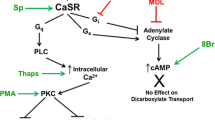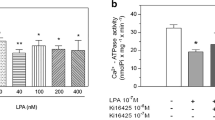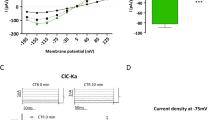Abstract
Background
The calcium-sensing receptor (CaSR) is localized in the apical membrane of proximal tubules in close proximity to the transporters responsible for proton secretion. Therefore, the aim of the present study was to analyze the effects of CaSR stimulation on the biochemical activity of the vacuolar H+-ATPase in a cellular model of proximal tubule cells, OKP cells.
Methods
Biochemical activity of H+-ATPase was performed using cell homogenates, and the inorganic phosphate released was determined by a colorimetric method. Changes in cytosolic ionized calcium [Ca2+]i were also determined using Fluo-4.
Results
A significant increase of vacuolar H+-ATPase activity was observed when the CaSR was stimulated with agonists such as Gd3+ (300 µM) and neomycin (200 µM). This activity was also stimulated in a dose-dependent fashion by changes in extracellular Ca2+ (Ca2+o) between 10−4 and 2 mM. Gd3+ and neomycin produced a sustained rise of [Ca2+]i, an effect that disappears when extracellular calcium was removed in the presence of 0.1 µM thapsigargin. Inhibition of phospholipase C (PLC) activity with U73122 (5 × 10−8 M) reduced the increase in [Ca2+]i induced by neomycin.
Conclusion
CaSR stimulation induces an increase in the vacuolar H+-ATPase activity of OKP cells, an effect that involves an increase in [Ca2+]i and require phospholipase C activity. The consequent decrease in intratubular pH could lead to increase ionization of luminal calcium, potentially enhancing its reabsorption in distal tubule segments and reducing the formation of calcium phosphate stones.






Similar content being viewed by others
References
Alfadda TI, Saleh AM, Houillier P, Geibel JP. Calcium-sensing receptor 20 years later. Am J Physiol. 2014;307(3):C221–31.
Riccardi D, Valenti G. Localization and function of the renal calcium-sensing receptor. Nat Rev Nephrol. 2016;12(7):414–25.
Riccardi D, Kemp PJ. The calcium-sensing receptor beyond extracellular calcium homeostasis: conception, development, adult physiology, and disease. Annu Rev Physiol. 2012;74:271–97.
Riccardi D, Lee WS, Lee K, et al. Localization of the extracellular Ca(2+)-sensing receptor and PTH/PTHrP receptor in rat kidney. Am J Physiol. 1996;271(4 Pt 2):F951–6.
Riccardi D, Hall AE, Chattopadhyhay N, et al. Localization of the extracellular Ca2+/polyvalent cation-sensing protein in rat kidney. Am J Physiol. 1998;274(3 Pt 2):611–22.
Graca J, Schepelmann M, Brennan S, et al. Comparative expression of the extracellular calcium-sensing receptor in the mouse, rat and human kidney. Am J Physiol. 2016;310(6):F518–33.
Loupy A, Ramakrishnan SK, Wootla B, et al. PTH-independent regulation of blood calcium concentration by the calcium-sensing receptor. J Clin Invest. 2012;122(9):3355–67.
Yasuoka Y, Sato Y, Healy JM, et al. pH-sensitive expression of calcium-sensing receptor (CaSR) in type-B intercalated cells of the cortical collecting ducts (CCD) in mouse kidney. Clin Exp Nephrol. 2015;19(5):771–82.
Ba J, Brown D, Friedman PA. Calcium-sensing receptor regulation of PTH-inhibitable proximal tubule phosphate transport. Am J Physiol. 2003;285(6):F1233–43.
Maiti A, Beckman MJ. Extracellular calcium is a direct effecter of VDR levels in proximal tubule epithelial cells that counter-balances effects of PTH on renal vitamin D metabolism. J Steroid Biochem Mol Biol. 2007;103(3–5):504–8.
Capasso G, Geibel PJ, Damiano S, et al. The calcium sensing receptor modulates fluid reabsorption and acid secretion in the proximal tubule. Kidney Int. 2013;84(2):277–84.
Procino G, Carmosino M, Tamma G, et al. Extracellular calcium antagonizes forskolin-induced aquaporin 2 trafficking in collecting duct cells. Kidney Int. 2004;66(6):2245–55.
Renkema KY, Velic A, Dijkman HB, et al. The calcium-sensing receptor promotes urinary acidification to prevent nephrolithiasis. J Am Soc Nephrol. 2009;20(8):1705–13.
Sands JM, Naruse M, Baum M, et al. Apical extracellular calcium/polyvalent cation-sensing receptor regulates vasopressin-elicited water permeability in rat kidney inner medullary collecting duct. J Clin Invest. 1997;99(6):1399–405.
Casare F, Milan D, Fernandez R. Stimulation of calcium-sensing receptor increases biochemical H+-ATPase activity in mouse cortex and outer medullary regions. Can J Physiol Pharmacol. 2014;92(3):181–8.
Cole JA, Forte LR, Krause WJ, Thorne PK. Clonal sublines that are morphologically and functionally distinct from parental OK cells. Am J Physiol. 1989;256(4 Pt 2):F672–9.
Dos Santos PMC, Freitas FP, Mendes J, Tararthuch AL, Fernandez R. Modulation of proton ATPase activity in MDCK-C11 cells. Can J Physiol Pharmacol. 2009;87(9):653–65.
Chang W, Shoback D. Extracellular Ca2+-sensing receptors—an overview. Cell Calcium. 2004;35(3):183–96.
Ward DT. Calcium receptor-mediated intracellular signalling. Cell Calcium. 2004;35(3):217–28.
Di Mise A, Tamma G, Ranieri M, et al. Conditionally immortalized human proximal tubular epithelial cells isolated from the urine of a healthy subject express functional calcium-sensing receptor. Am J Physiol. 2015;308(11):F1200–6.
Wagner CA, Finberg KE, Breton S, et al. Renal vacuolar H+-ATPase. Physiol Rev. 2004;84(4):1263–314.
Brown EM, Watson EJ, Leombruno R, Underwood RH. Extracellular calcium is not necessary for acute, low calcium- or dopamine-stimulated PTH secretion in dispersed bovine parathyroid cells. Metabolism. 1983;32(11):1038–44.
Fernandez R, Giebisch G, Geibel JP. Intracellular Ca2+ modulates H+ ATPase activity in intercalated cells from mouse cortical collecting duct (CCD). Faseb J. 2005;19(4):139. (Abstract Meeting).
Zhang C, Miller CL, Gorkhali R, et al. Molecular basis of the extracellular ligands mediated signaling by the calcium sensing receptor. Front Physiol. 2016;7:441.
Quinn SJ, Conigrave AD. Alternative agonists and modulators: evidence that the calcium-sensing receptor is a multi-modal sensor. Calcium Sens Recept. 2003;19:203–26.
Farajov EL, Morimoto T, Aslanova UF, et al. Calcium-sensing receptor stimulates luminal K+-dependent H+ excretion in medullary thick ascending limbs of Henle’s loop of mouse kidney. Tohoku J Exp Med. 2008;216(1):7–15.
Colella M, Gerbino A, Hofer AM, Curci S. Recent advances in understanding the extracellular calcium-sensing receptor. F1000Res. 2016; 5(F1000 Faculty Rev):2535. https://doi.org/10.12688/f1000research.8963.1
Ward DT, McLarnon SJ, Riccardi D. Aminoglycosides increase intracellular calcium levels and ERK activity in proximal tubular OK cells expressing the extracellular calcium-sensing receptor. J Am Soc Nephrol. 2002;13(6):1481–9.
Hays SR, Alpern RJ. Inhibition of Na(+)-independent H+ pump by Na(+)-induced changes in cell Ca2+. J Gen Physiol. 1991;98(4):791–813.
Van de Graaf SF, Bindels RJ, Hoenderop JG. Physiology of epithelial Ca2+ and Mg2+ transport. Rev Physiol Biochem Pharmacol. 2007;158:77–160.
Tiselius HG. A hypothesis of calcium stone formation: an interpretation of stone research during the past decades. Urol Res. 2011;39(4):231–43.
Wagner CA, Mohebbi N. Urinary pH and stone formation. J Nephrol. 2010;23(16):165–9.
Wang W, Praetorius J, Li C, et al. Vacuolar H+-ATPase expression is increased in acid-secreting intercalated cells in kidneys of rats with hypercalcaemia-induced alkalosis. Acta Physiol (Oxf). 2007;189(4):359–68.
Vezzoli G, Terranegra A, Rainone F, et al. Calcium-sensing receptor and calcium kidney stones. J Transl Med. 2011;9:201.
Vezzoli G, Terranegra A, Aloia A, et al. Decreased transcriptional activity of calcium-sensing receptor gene promoter 1 is associated with calcium nephrolithiasis. J Clin Endocrinol Metab. 2013;98(9):3839–47.
Bergsland KJ, Coe FL, Gillen DL, Worcester EM. A test of the hypothesis that the collecting duct calcium-sensing receptor limits rise of urine calcium molarity in hypercalciuric calcium kidney stone formers. Am J Physiol. 2009;297(4):F1017–23.
Acknowledgements
P. M. C. Dos Santos was supported by a grant of CAPES (Coordenação de Aperfeiçoamento de Pessoal de Nível Superior), Brasil. The authors acknowledge the Confocal and Conventional Fluorescence Microscopy Multi-user Laboratory at UFPR for technical support. This laboratory is supported by FINEP, Brazil.
Author information
Authors and Affiliations
Corresponding author
Ethics declarations
Conflict of interest
All the authors have declared no competing interest.
Research involving human participants and animals
This article does not contain any studies with human participants performed by any of the authors.
Informed consent
For this type of article, informed consent is not required.
About this article
Cite this article
Dos Santos, P.M.C., Amaral, D., Tararthuch, A.L. et al. Calcium-sensing receptor (CaSR) modulates vacuolar H+-ATPase activity in a cell model of proximal tubule. Clin Exp Nephrol 22, 1258–1265 (2018). https://doi.org/10.1007/s10157-018-1613-z
Received:
Accepted:
Published:
Issue Date:
DOI: https://doi.org/10.1007/s10157-018-1613-z




